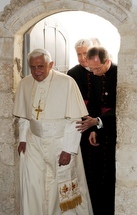Pope Visits Upper Room

Pope Benedict XVI yesterday visited some of the holiest places in Judaism and Islam, including a stop at a humble yet holy setting: the Cenacle, the Shrine of the Last Supper, where essentially the Church was born.
There, the Pope greeted the bishops of the Holy Land with “great joy,” noting the importance of this place where the Eucharist was instituted. Through the mystery of the Eucharist, he said, “our lives become a grateful, docile and active acceptance of the power of a love which is given to us.”
This transforming love, the Holy Father added, “prompts us, as individuals and communities, to overcome the temptation to turn in upon ourselves in selfishness or indolence, isolation, prejudice or fear, and to give ourselves generously to the Lord and to others.”
Welcoming Benedict to the Upper Room, Father Pierbattista Pizzaballa, the Franciscan custos of the Holy Land, noted that of all the holy places on the papal pilgrimage “this is certainly the least glorious from the architectural point of view; probably it is the smallest and, let’s admit it, perhaps even the one least well looked after. Yet it is moving to welcome you here — in particular, the joy of welcoming you here is truly something very special.”
Father Pizzaballa recalled the Franciscans’ long historical ties with the Cenacle, remembering that the order had its first monastery there before moving on to the Basilica of the Holy Sepulcher. The custos explained how, after “great expense and with exhausting negotiations,” the Cenacle came into the Franciscans’ possession as a gift from the king and queen of Naples.
However, two centuries later, the Ottoman rulers of Jerusalem expelled the Franciscans by force, and now the Cenacle is in the hands of the Israeli government. The Franciscan Custody still retains the right of property, however, and to this day has called for its restitution. Israel has reportedly promised to return it, but has not yet done so.
In his address, Father Pizzaballa said that in the Cenacle “all the contradictions of the Holy Land can be clearly seen, in the neglect of the stones of the place — the different dominations that have followed on one another, the overlapping devotions, the division of the Church and the different particularisms.”
“In a certain sense,” he added, “the Cenacle marks the place of the holiness of God, his unconditional love, and the smallness of man.”














